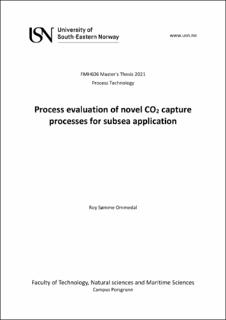| dc.description.abstract | With a subsea module for sweetening of natural gas, it is possible to extract natural gas
from places with a too high concentration of CO2 is too remote or both. The separated gas
containing a high amount of CO2 needs to be reinjected into the reservoir.
In this work, it is given an overview of the different alternative of what can be
implemented. Some membrane based process alternative are simulated with polymer
membranes at different specification and parameters. To lower the CO2 content down to
8 mol%, with a feed flow of 2MSm3 that contains CO2 of 80-, 50- and 20 mol% and the
rest are methane.
The membrane area required for a crossflow model were 105 000m2, 188 000m2 and 203
000m2, and for a countercurrent model 94 000m2, 176 000m2 and 200 000m2,
respectively. The crossflow model used are from an example in Aspen Custom Modeler
implemented in Aspen Plus. The countercurrent model is from literature.
For the same cases with multi components, and CO2 remains the same and other
components such as C2, C3, C4 and water are added. The membrane area for a crossflow
model was 93 000m2, 157 000m2 and 158 000m2. A case with a two stage membrane
system to bring the retentate flow to natural gas specification (2mol% CO2) with feed
content of 80mol% CO2. That case required a membrane area of 106 000m2 and 246
000m2 and a recycle compressor at 718kW. An advantage of this is that the natural gas
reaches sales specs. However, this leads to more equipment used where the focus is to
minimize equipment.
For the case with 20mol% CO2 in the feed, an estimated subsea module would cost ~62
mill. USD with operational cost annually ~1.5 mill. USD. With a potential theoretical
income of ~45 mill. USD with natural gas annually, this case seems promising.
For the case with 80mol% CO2 in the feed, an estimated subsea module would cost ~146
mill. USD with operational cost annually ~5.8 mill. USD. With a potential theoretical
income of ~10 mill. USD with natural gas annually, this is not economical in the view of
natural gas income. However, if there is a marked for CO2 enhanced oil recovery in some
nearby field, the CO2 rich gas could be sold. | |
